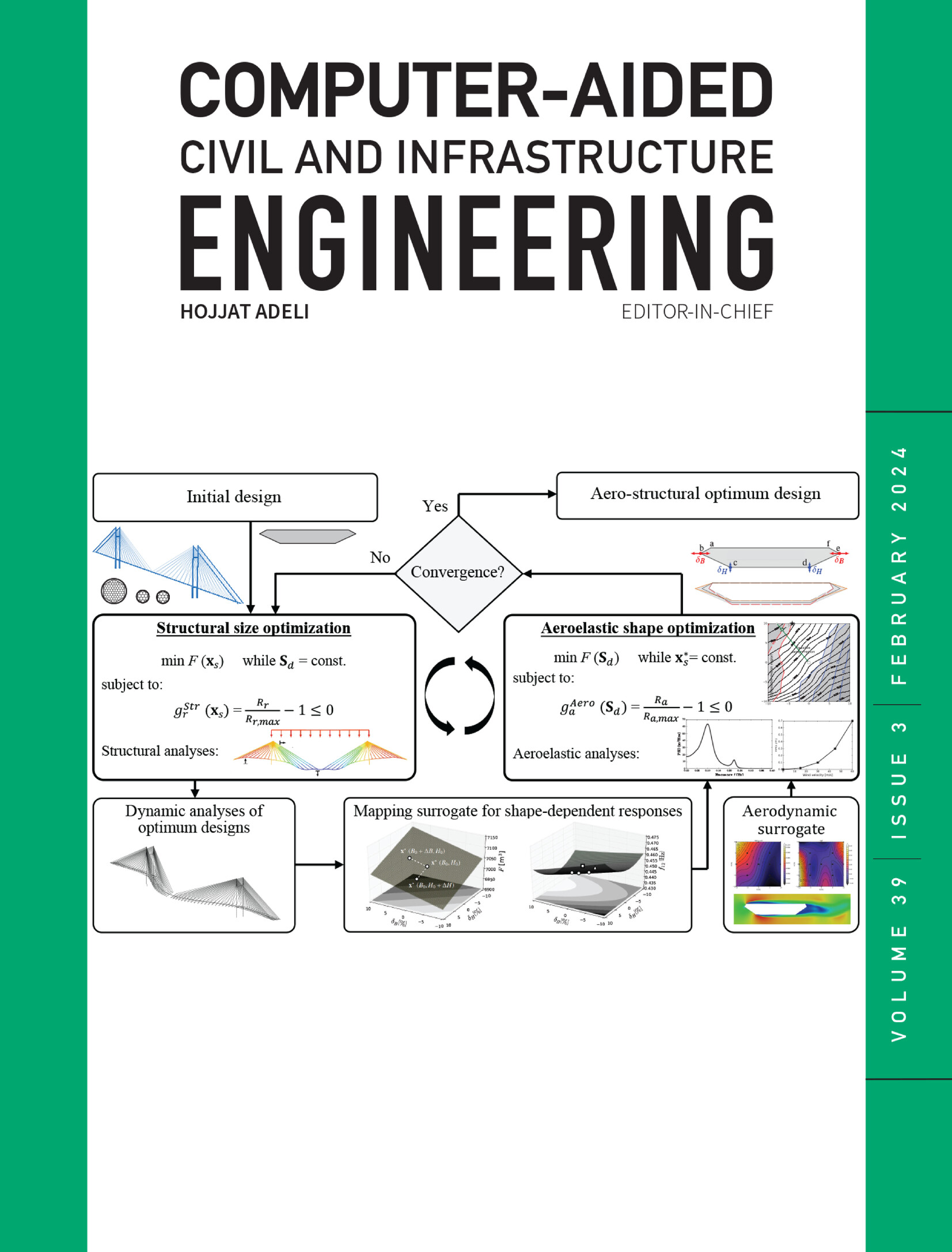Computer vision wireless sensors for displacement influence line/surface measurement of footbridges using stationary pedestrian loading
IF 8.5
1区 工程技术
Q1 COMPUTER SCIENCE, INTERDISCIPLINARY APPLICATIONS
引用次数: 0
Abstract
Although using a heavy vehicle at a consistent speed is a common method to estimate displacement influence lines or displacement influence surfaces (DILs/DISs) of vehicular bridges, it requires algorithms to separate the dynamic and static components from measured displacements. This decomposition process can introduce uncertainties in the results. Additionally, employing vehicles is logistically impractical for most footbridges. To overcome these issues, this paper proposes a new, practical framework using computer vision to measure DILs/DISs on footbridges. It combines a stationary pedestrian loading strategy with a computer vision input–output wireless sensor network (CVIO‐WSN). This framework has two main features: (1) pedestrians follow the “step‐and‐stand” rule, and their weight acts as a static load when they stand still at discrete locations across the footbridge for DIL/DIS measurement; (2) CVIO‐WSN consists of input nodes for human load localization and output nodes for simultaneous structural response measurement, allowing load and response data to be collected in a contactless way that minimizes disruption to operational structures. Two laboratory experiments were conducted to validate this system. The first evaluated the timestamping accuracy between two identical sensor nodes tracking the same moving target, showing an average synchronization error of 2.39 ms. The second assessed the localization accuracy of the input nodes, with the average error of 14.0 mm on the X‐axis and 16.9 mm on the Y‐axis. The method was then applied to an experimental floor structure and an operational full‐scale footbridge. In the first application, the input nodes tracked a human through a sequence of 77 locations across the floor, while the output node measured structural displacement at the center, successfully obtaining the structural DIS. In the second application, the method localized four humans (pedestrians) moving to discrete locations across an operational arch footbridge and briefly remaining stationary while measuring displacement at two points of the structure. Although the measurement results were promising, using heavier pedestrians or increasing their number is recommended to improve the signal‐to‐noise ratio of the structural displacement measurements.计算机视觉无线传感器位移影响线/面测量行人桥使用固定行人负载
虽然以一致速度使用重型车辆是估计车桥位移影响线或位移影响面(DILs/DISs)的常用方法,但它需要将动态和静态分量与测量位移分开的算法。这种分解过程会在结果中引入不确定性。此外,对于大多数人行桥来说,使用车辆在后勤上是不切实际的。为了克服这些问题,本文提出了一种新的实用框架,使用计算机视觉来测量人行天桥上的DILs/DISs。它结合了静止行人加载策略和计算机视觉输入输出无线传感器网络(CVIO - WSN)。该框架具有两个主要特征:(1)行人遵循“步-站”规则,当他们在横跨人行桥的离散位置静止不动时,他们的体重充当静态负载进行DIL/DIS测量;(2) CVIO‐WSN由用于人类负载定位的输入节点和用于同时测量结构响应的输出节点组成,允许以非接触方式收集负载和响应数据,从而最大限度地减少对运行结构的破坏。进行了两个实验室实验来验证该系统。第一个评估了跟踪同一运动目标的两个相同传感器节点之间的时间戳精度,显示平均同步误差为2.39 ms。第二部分评估了输入节点的定位精度,X轴上的平均误差为14.0 mm, Y轴上的平均误差为16.9 mm。然后将该方法应用于一个实验楼面结构和一个实际的全尺寸人行天桥。在第一个应用程序中,输入节点通过地板上77个位置的序列跟踪一个人,而输出节点在中心测量结构位移,成功获得结构DIS。在第二个应用程序中,该方法定位了四个人(行人),他们移动到一个可操作的拱桥上的离散位置,并在测量结构两点的位移时短暂保持静止。虽然测量结果很有希望,但建议使用较重的行人或增加他们的数量来提高结构位移测量的信噪比。
本文章由计算机程序翻译,如有差异,请以英文原文为准。
求助全文
约1分钟内获得全文
求助全文
来源期刊
CiteScore
17.60
自引率
19.80%
发文量
146
审稿时长
1 months
期刊介绍:
Computer-Aided Civil and Infrastructure Engineering stands as a scholarly, peer-reviewed archival journal, serving as a vital link between advancements in computer technology and civil and infrastructure engineering. The journal serves as a distinctive platform for the publication of original articles, spotlighting novel computational techniques and inventive applications of computers. Specifically, it concentrates on recent progress in computer and information technologies, fostering the development and application of emerging computing paradigms.
Encompassing a broad scope, the journal addresses bridge, construction, environmental, highway, geotechnical, structural, transportation, and water resources engineering. It extends its reach to the management of infrastructure systems, covering domains such as highways, bridges, pavements, airports, and utilities. The journal delves into areas like artificial intelligence, cognitive modeling, concurrent engineering, database management, distributed computing, evolutionary computing, fuzzy logic, genetic algorithms, geometric modeling, internet-based technologies, knowledge discovery and engineering, machine learning, mobile computing, multimedia technologies, networking, neural network computing, optimization and search, parallel processing, robotics, smart structures, software engineering, virtual reality, and visualization techniques.

 求助内容:
求助内容: 应助结果提醒方式:
应助结果提醒方式:


